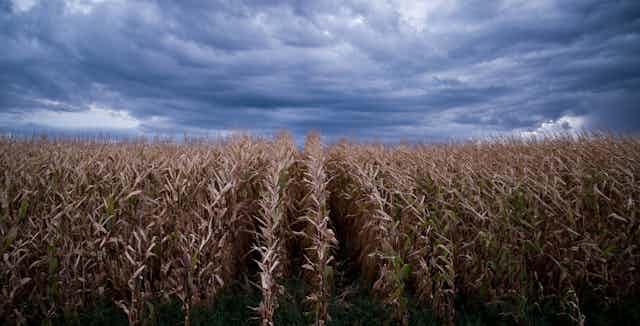The recent news of Monsanto’s US$930m acquisition of data science company Climate Corporation, raises important questions about the economies developing in response to climate change.
A new generation of companies have emerged that harness new methods of data analysis to turn vast datasets (“big data”) into exploitable, marketable information. As the Financial Times reported, Monsanto’s purchase signals the first significant “big data” acquisition.
Climate Corporation offers an online self-service weather insurance for US farmers. In addition to the company’s standard crop insurance, this Total Weather Insurance pays out solely on the basis of observed weather conditions, rather than crop damage. If the observed weather conditions trigger a pay-out, a cheque is automatically generated and arrives within days of the end of the policy coverage period.
In order to calculate the price of policies and pay-outs, Climate Corporation data scientists analyse three million new data points a day from 22 datasets using advanced analysis techniques. The data comes from a range of third-party providers such as the US National Weather Service, which publishes its data free for re-use.
Old dog, new tricks
Total Weather Insurance is a new form of financial product being sold direct to farmers, but what underlies it is not new. Weather derivatives were developed by the likes of Enron, Koch Industries and Aquila in the mid-1990s. Enron found insurance companies were unwilling to insure against non-extreme weather events, so the company created its own, which worked in a similar way to Total Weather Insurance, paying out if certain conditions are met, regardless of any actual loss. By presenting it as a derivative, and therefore a financial product rather than an insurance product, Enron could skirt the regulatory constraints placed on energy companies’ use of insurance products.
Weather derivative contracts can be traded across any type of weather, the most popular by far are based on the divergence of the average daily temperature from 18 degrees. These products are known as Heating and Cooling Degree Days contracts. The mid-2000s saw massive growth in the weather derivatives market, but it crashed alongside everything else in 2008.
However, the Weather Risk Management Association is hopeful for weather derivatives, pointing to continuing growth outside the US markets throughout the downturn, growing interest in non-temperature-related weather derivatives, and increasing interest from outside the energy industry.
Free the data
Until recently, UK traders had to purchase weather data from the Met Office in order to conduct forecast analyses and price weather derivatives contracts. The financial services sector has long complained that the weather risk and derivatives markets in the UK have been restrained by the lack of freely available weather data, and accordingly have lobbied for a data access and re-use policy similar to the USA. In 2011, the new coalition government obliged, announcing that, as part of its Open Government Data initiative, “the largest volume of high quality weather data and information made available by a national meteorological organisation anywhere in the world” would be opened for anyone to re-use without charge.
The entrance of Monsanto into the weather risk market represents the growing interest in these products outside of the energy sector – in this case agriculture. The combination of increasing amounts of freely available and re-usable weather data, the development of more advanced big data analysis techniques, the growing global demand for a variety of weather products, and the development of simple online self-service portals for buyers all suggest that the exploitation of unstable weather systems is still in its early days.
Big players, big risks
Crucially, these developments expand the range of players with a financial interest in continuing climate instability. Whilst the claim is often made that weather derivatives and similar products balance out the financial impact of weather on affected businesses, thus smoothing adaptation to climate change, serious political-economic questions do arise about who actually benefits from these financial products.
The model of paying out based upon observed weather means, in effect, placing bets on future weather conditions – rather than a business insuring itself against a specific loss. Clearly, during a time of instability in global weather, there is a lot of potential profit to be generated from such financial products. The emergence of this developing data-driven weather derivatives and risk market is, therefore, troubling.
It exploits common threats in order to generate private wealth and favours those in a financial position to protect their interests at the expense of those most vulnerable to climate instabilities. Most dangerously, this practice could reduce the incentive for those profiting from these markets to engage in action to mitigate climate change.
This article also appears on the SPERI blog at the University of Sheffield

